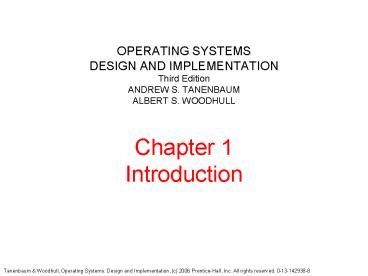OPERATING SYSTEMS DESIGN AND IMPLEMENTATION Third Edition ANDREW S. TANENBAUM ALBERT S. WOODHULL Chapter 1 Introduction - PowerPoint PPT Presentation
1 / 33
Title:
OPERATING SYSTEMS DESIGN AND IMPLEMENTATION Third Edition ANDREW S. TANENBAUM ALBERT S. WOODHULL Chapter 1 Introduction
Description:
OPERATING SYSTEMS DESIGN AND IMPLEMENTATION Third Edition ANDREW S. TANENBAUM ALBERT S. WOODHULL Chapter 1 Introduction The Modern Computer System Figure 1.1 A ... – PowerPoint PPT presentation
Number of Views:1111
Avg rating:3.0/5.0
Title: OPERATING SYSTEMS DESIGN AND IMPLEMENTATION Third Edition ANDREW S. TANENBAUM ALBERT S. WOODHULL Chapter 1 Introduction
1
OPERATING SYSTEMSDESIGN AND IMPLEMENTATIONThird
EditionANDREW S. TANENBAUMALBERT S.
WOODHULLChapter 1Introduction
2
The Modern Computer System
- Figure 1.1 A computer system consists of
hardware, system programs, and application
programs.
3
What Is an Operating System?
- The operating system has two basic
- functions of the operating system
- It is an extended machine or virtual machine
- Easier to program than the underlying hardware
- It is a resource manager
- Shares resources in time and space
4
Operating System Generations
- Generation 1 (1945 55) Vacuum tubes and
plugboards - Generation 2 (1955 65)Transistors and batch
systems - Generation 3 (1965 80)ICs and multiprogramming
- Generation 4 (1980 Present)Personal computers
5
Early Batch System (1)
- Figure 1-2. An early batch system. (a)
Programmers bring cards to 1401. (b)1401 reads
batch of jobs onto tape.
6
Early Batch System (2)
- Figure 1-2. An early batch system. (c) Operator
carries input tape to 7094. (d) 7094 does
computing.
7
Early Batch System (3)
- Figure 1-2. An early batch system. (e) Operator
carries output tape to 1401. (f) 1401 prints
output.
8
Early Batch System (4)
- Figure 1-3. Structure of a typical FMS job.
9
Multiprogramming
- Figure 1-4. A multiprogramming system
- with three jobs in memory.
10
Processes
- Figure 1-5. A process tree. Process A created two
child - processes, B and C. Process B created three child
- processes, D, E, and F.
11
File Systems (1)
- Figure 1-6. A file system for a university
department.
12
File Systems (2)
- Figure 1-7. (a) Before mounting, the files on
drive 0 are not accessible. (b) After mounting,
they are part of the file hierarchy.
13
File Systems (3)
- Figure 1-8. Two processes connected by a pipe.
14
System Calls (1)
Process Management
- Figure 1-9. The MINIX system calls. fd is a file
descriptor - and n is a byte count.
15
System Calls (2)
Signals
- Figure 1-9. The MINIX system calls. fd is a file
descriptor - and n is a byte count.
16
System Calls (3)
File Management
- Figure 1-9. The MINIX system calls. fd is a file
descriptor - and n is a byte count.
17
System Calls (4)
Dir. File System Mgmt.
- Figure 1-9. The MINIX system calls. fd is a file
descriptor - and n is a byte count.
18
System Calls (5)
Protection
- Figure 1-9. The MINIX system calls. fd is a file
descriptor - and n is a byte count.
19
System Calls (6)
Time Management
- Figure 1-9. The MINIX system calls. fd is a file
descriptor - and n is a byte count.
20
The fork Call in the Shell
- Figure 1-10. A stripped-down shell. Throughout
this book, TRUE is assumed to be defined as 1.
21
Processes
- Figure 1-11. Processes have three segments text,
data, and stack. In this example, all three are
in one address space, but separate instruction
and data space is also supported.
22
System Calls for File Management (1)
- Figure 1-12. The structure used to return
information for the stat and fstat system calls.
In the actual code, symbolic names are used for
some of the types.
23
System Calls for File Management (2)
- Figure 1-13. A skeleton for setting up a
two-process pipeline.
24
System Calls for File Management (3)
- Figure 1-13. A skeleton for setting up a
two-process pipeline.
25
System Calls for Directory Management (1)
link(/usr/jim/memo,/usr/ast/note)
- Figure 1-14. (a) Two directories before linking
/usr/jim/memo to asts directory. (b) The same
directories after linking.
26
System Calls for Directory Management (2)
mount(/dev/cdrom0,/mnt,0)
- Figure 1-15. (a) File system before the mount.
(b) File system after the mount.
27
Operating System Structure
- Figure 1-16. The 11 steps in making the system
call read(fd, buffer, nbytes).
28
Basic Structure for Operating System
- A main program that invokes the requested service
procedure - A set of service procedures that carry out the
system calls - A set of utility procedures that help the service
procedures
29
Layered Systems (1)
- Figure 1-17. A simple structuring model for a
monolithic system.
30
Layered Systems (2)
- Figure 1-18. Structure of the THE operating
system.
31
Virtual Machines
- Figure 1-19. The structure of VM/370 with CMS.
32
Client-Server Model (1)
- Figure 1-20. The client-server model.
33
Client-Server Model (2)
- Figure 1-21. The client-server model in a
distributed system.

